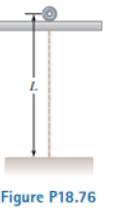
Concept explainers
A nylon siring has mass 5.50 g and length L = 86.0 cm. The lower end is tied to the floor, and the upper end is tied to a small set of wheels through a slot in a track on which the wheels move (Fig. P18.76). The wheels have a mass that is negligible compared with that of the siring, and they roll without friction on the track so that the upper end of the string is essentially free. Figure P18.76 At equilibrium, the string is vertical and motionless. When it is carrying a small-amplilude wave, you may assume the string is always under uniform tension 1.30 N. (a) Find the speed of transverse waves on the siring, (b) The string's vibration possibilities are a set of standing-wave states, each with a node at the fixed bottom end and an antinode at the free top end. Find the node-antinode distances for each of the three simplest states, (c) Find the frequency of each of these states.

(a)
The speed of transverse waves on the string.
Answer to Problem 18.76AP
The speed of transverse waves on the string is
Explanation of Solution
Given info: The length of the string is
The linear mass density of the string is,
Here,
Substitute
The formula for speed of string is,
Here,
Substitute
Conclusion:
Therefore, the speed of transverse waves on the string is
(b)
The node-antinodes distances for each of the three simplest states.
Answer to Problem 18.76AP
The node-antinodes distances are
Explanation of Solution
Given info: The length of the string is
Consider the first condition in which a node is formed at the fixed bottom and an antinode is at top.
For the above condition, the length of the string is,
Here,
Rewrite the above equation.
Substitute
The node-antinodes distance is,
Substitute
Consider the second condition in which two node is formed and an antinode is at top.
For the above condition, the length of the string is,
Rewrite the above equation.
Substitute
Thus, the wavelength is
Substitute
Consider the third condition in which three node is formed and an antinode is at top.
For the above condition, the length of the string is,
Rewrite the above equation.
Substitute
Thus, the wavelength is
Substitute
Conclusion:
Therefore, the node-antinodes distances are
(c)
The frequency of each conditions in part (b).
Answer to Problem 18.76AP
The frequencies are
Explanation of Solution
Given info: The length of the string is
The formula of frequency is,
Here,
For fist condition:
Substitute
For second condition:
Substitute
For third condition:
Substitute
Conclusion:
Therefore, the frequencies are
Want to see more full solutions like this?
Chapter 18 Solutions
EBK PHYSICS FOR SCIENTISTS AND ENGINEER
- Part C Find the height yi from which the rock was launched. Express your answer in meters to three significant figures. Learning Goal: To practice Problem-Solving Strategy 4.1 for projectile motion problems. A rock thrown with speed 12.0 m/s and launch angle 30.0 ∘ (above the horizontal) travels a horizontal distance of d = 19.0 m before hitting the ground. From what height was the rock thrown? Use the value g = 9.800 m/s2 for the free-fall acceleration. PROBLEM-SOLVING STRATEGY 4.1 Projectile motion problems MODEL: Is it reasonable to ignore air resistance? If so, use the projectile motion model. VISUALIZE: Establish a coordinate system with the x-axis horizontal and the y-axis vertical. Define symbols and identify what the problem is trying to find. For a launch at angle θ, the initial velocity components are vix=v0cosθ and viy=v0sinθ. SOLVE: The acceleration is known: ax=0 and ay=−g. Thus, the problem becomes one of…arrow_forwardPhys 25arrow_forwardPhys 22arrow_forward
 Physics for Scientists and Engineers, Technology ...PhysicsISBN:9781305116399Author:Raymond A. Serway, John W. JewettPublisher:Cengage Learning
Physics for Scientists and Engineers, Technology ...PhysicsISBN:9781305116399Author:Raymond A. Serway, John W. JewettPublisher:Cengage Learning Principles of Physics: A Calculus-Based TextPhysicsISBN:9781133104261Author:Raymond A. Serway, John W. JewettPublisher:Cengage Learning
Principles of Physics: A Calculus-Based TextPhysicsISBN:9781133104261Author:Raymond A. Serway, John W. JewettPublisher:Cengage Learning Physics for Scientists and Engineers: Foundations...PhysicsISBN:9781133939146Author:Katz, Debora M.Publisher:Cengage Learning
Physics for Scientists and Engineers: Foundations...PhysicsISBN:9781133939146Author:Katz, Debora M.Publisher:Cengage Learning Physics for Scientists and EngineersPhysicsISBN:9781337553278Author:Raymond A. Serway, John W. JewettPublisher:Cengage Learning
Physics for Scientists and EngineersPhysicsISBN:9781337553278Author:Raymond A. Serway, John W. JewettPublisher:Cengage Learning Physics for Scientists and Engineers with Modern ...PhysicsISBN:9781337553292Author:Raymond A. Serway, John W. JewettPublisher:Cengage Learning
Physics for Scientists and Engineers with Modern ...PhysicsISBN:9781337553292Author:Raymond A. Serway, John W. JewettPublisher:Cengage Learning College PhysicsPhysicsISBN:9781285737027Author:Raymond A. Serway, Chris VuillePublisher:Cengage Learning
College PhysicsPhysicsISBN:9781285737027Author:Raymond A. Serway, Chris VuillePublisher:Cengage Learning





